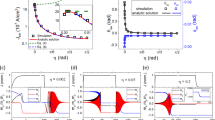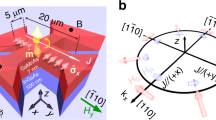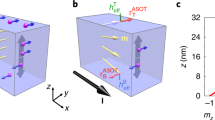Abstract
Spin–orbit coupling can convert a charge current into a spin current, thereby generating a spin–orbit torque (SOT). Energy-efficient, commercially viable SOT technology requires field-free switching of perpendicular magnetization at low current. In heterostructures incorporating ferromagnets, the polarization of spin current consists, in general, of three vectors: \(( {{{{\hat{\mathrm z}}}} \times {{{\hat{\mathrm E}}}}} )\), \({{{\hat{\mathrm m}}}}\) and \({{{\hat{\mathrm m}}}} \times ( {{{{\hat{\mathrm z}}}} \times {{{\hat{\mathrm E}}}}} )\), where \({{{\hat{\mathrm z}}}}\) is the film normal, \({{{\hat{\mathrm E}}}}\) is the electric-field direction and \({{{\hat{\mathrm m}}}}\) is the magnetization direction. Previous studies on SOT have used only part of all the three polarizations, because the two \({{{\hat{\mathrm m}}}}\)-dependent polarizations are mutually orthogonal. Here we show that all the three polarizations can be exploited in systems with ferromagnet/non-magnet/ferromagnet trilayers, having a bottom epitaxial ferromagnet layer with a tilted magnetic easy axis. The approach reduces the field-free SOT switching current compared with approaches that exploit only part of all the three polarizations. We also show that this technique can be used with a sputtered polycrystalline trilayer, illustrating its potential applicability to mass production.
This is a preview of subscription content, access via your institution
Access options
Access Nature and 54 other Nature Portfolio journals
Get Nature+, our best-value online-access subscription
$29.99 / 30 days
cancel any time
Subscribe to this journal
Receive 12 digital issues and online access to articles
$119.00 per year
only $9.92 per issue
Buy this article
- Purchase on Springer Link
- Instant access to full article PDF
Prices may be subject to local taxes which are calculated during checkout




Similar content being viewed by others
Data availability
Source data are provided with this paper. The data that support the findings of this study are available from the corresponding authors upon reasonable request.
Change history
10 June 2022
A Correction to this paper has been published: https://doi.org/10.1038/s41928-022-00790-2
References
Wolf, S. A. et al. Spintronics: a spin-based electronics vision for the future. Science 294, 1488–1495 (2001).
Žutić, I., Fabian, J. & Sarma, S. D. Spintronics: fundamentals and applications. Rev. Mod. Phys. 76, 323 (2004).
Manchon, A. et al. Current-induced spin-orbit torques in ferromagnetic and antiferromagnetic systems. Rev. Mod. Phys. 91, 035004 (2019).
Ryu, J., Lee, S., Lee, K.-J. & Park, B.-G. Current-induced spin–orbit torques for spintronic applications. Adv. Mater. 32, 1907148 (2020).
Miron, I. M. et al. Perpendicular switching of a single ferromagnetic layer induced by in-plane current injection. Nature 476, 189–193 (2011).
Liu, L. et al. Spin-torque switching with the giant spin Hall effect of tantalum. Science 336, 555–558 (2012).
Kim, J. et al. Layer thickness dependence of the current-induced effective field vector in Ta|CoFeB|MgO. Nat. Mater. 12, 240–245 (2013).
Garello, K. et al. Symmetry and magnitude of spin–orbit torques in ferromagnetic heterostructures. Nat. Nanotechnol. 8, 587–593 (2013).
Hayashi, M., Kim, J., Yamanouchi, M. & Ohno, H. Quantitative characterization of the spin-orbit torque using harmonic Hall voltage measurements. Phys. Rev. B 89, 144425 (2014).
Baumgartner, M. et al. Spatially and time-resolved magnetization dynamics driven by spin–orbit torques. Nat. Nanotechnol. 12, 980–986 (2017).
Dyakonov, M. I. & Perel, V. I. Current-induced spin orientation of electrons in semiconductors. Phys. Lett. A 35, 459–460 (1971).
Sinova, J., Valenzuela, S. O., Wunderlich, J., Back, C. H. & Jungwirth, T. Spin Hall effects. Rev. Mod. Phys. 87, 1213 (2015).
Yu, G. et al. Switching of perpendicular magnetization by spin–orbit torques in the absence of external magnetic field. Nat. Nanotechnol. 9, 548–554 (2014).
You, L. et al. Switching of perpendicularly polarized nanomagnets with spin orbit torque without an external magnetic field by engineering a tilted anisotropy. Proc. Natl Acad. Sci. USA 112, 10310–10315 (2015).
MacNeill, D. et al. Control of spin–orbit torques through crystal symmetry in WTe2/ferromagnet bilayers. Nat. Phys. 13, 300–305 (2017).
Liu, L. et al. Symmetry-dependent field-free switching of perpendicular magnetization. Nat. Nanotechnol. 16, 277–282 (2021).
Fukami, S., Zhang, C., Duttagupta, S., Kurenkov, A. & Ohno, H. Magnetization switching by spin–orbit torque in an antiferromagnet–ferromagnet bilayer system. Nat. Mater. 15, 535–542 (2016).
Oh, Y.-W. et al. Field-free switching of perpendicular magnetization through spin–orbit torque in antiferromagnet/ferromagnet/oxide structures. Nat. Nanotechnol. 11, 878–884 (2016).
Lau, Y. C., Betto, D., Rode, K., Coey, J. M. D. & Stamenov, P. Spin–orbit torque switching without an external field using interlayer exchange coupling. Nat. Nanotechnol. 11, 758–762 (2016).
van den Brink, A. et al. Field-free magnetization reversal by spin-Hall effect and exchange bias. Nat. Commun. 7, 10854 (2016).
Cai, K. et al. Electric field control of deterministic current-induced magnetization switching in a hybrid ferromagnetic/ferroelectric structure. Nat. Mater. 16, 712–716 (2017).
Baek, S. C. et al. Spin currents and spin–orbit torques in ferromagnetic trilayers. Nat. Mater. 17, 509–513 (2018).
Amin, V. P., Zemen, J. & Stiles, M. D. Interface-generated spin currents. Phys. Rev. Lett. 121, 136805 (2018).
Oh, Y.-W., Ryu, J., Kang, J. & Park, B.-G. Material and thickness investigation in ferromagnet/Ta/CoFeB trilayers for enhancement of spin–orbit torque and field-free switching. Adv. Electron. Mater. 5, 1900598 (2019).
Lee, K.-S., Lee, S.-W., Min, B.-C. & Lee, K.-J. Threshold current for switching of a perpendicular magnetic layer induced by spin Hall effect. Appl. Phys. Lett. 102, 112410 (2013).
Taniguchi, T., Mitani, S. & Hayashi, M. Critical current destabilizing perpendicular magnetization by the spin Hall effect. Phys. Rev. B 92, 024428 (2015).
Grimaldi, E. et al. Single-shot dynamics of spin–orbit torque and spin transfer torque switching in three-terminal magnetic tunnel junctions. Nat. Nanotechnol. 15, 111–117 (2020).
Krizakova, V., Garello, K., Grimaldi, E., Kar, G. S. & Gambardella, P. Field-free switching of magnetic tunnel junctions driven by spin–orbit torques at sub-ns timescales. Appl. Phys. Lett. 116, 232406 (2020).
Brataas, A., Kent, A. D. & Ohno, H. Current-induced torques in magnetic materials. Nat. Mater. 11, 372–381 (2012).
Hahn, C. et al. Time-resolved studies of the spin-transfer reversal mechanism in perpendicularly magnetized magnetic tunnel junctions. Phys. Rev. B 94, 214432 (2016).
Tomita, H. et al. Single-shot measurements of spin-transfer switching in CoFeB/MgO/CoFeB magnetic tunnel junctions. Appl. Phys. Express 1, 061303 (2008).
Taniguchi, T., Grollier, J. & Stiles, M. D. Spin-transfer torques generated by the anomalous Hall effect and anisotropic magnetoresistance. Phys. Rev. Appl. 3, 044001 (2015).
Iihama, S. et al. Spin-transfer torque induced by the spin anomalous Hall effect. Nat. Electron. 1, 120–123 (2018).
Gibbons, J. D., Macneill, D., Buhrman, R. A. & Ralph, D. C. Reorientable spin direction for spin current produced by the anomalous Hall effect. Phys. Rev. Appl. 9, 064033 (2018).
Bose, A. et al. Observation of anomalous spin torque generated by a ferromagnet. Phys. Rev. Appl. 9, 064026 (2018).
Lifshits, M. B. & Dyakonov, M. I. Swapping spin currents: interchanging spin and flow directions. Phys. Rev. Lett. 103, 186601 (2009).
Mohamed, H. B. M. & Manchon, A. Spin-swapping transport and torques in ultrathin magnetic bilayers. Phys. Rev. Lett. 117, 036601 (2016).
Yang, Y. et al. Anomalous Hall magnetoresistance in a ferromagnet. Nat. Commun. 9, 2255 (2018).
Wang, X., Vanderbilt, D., Yates, J. R. & Souza, I. Fermi-surface calculation of the anomalous Hall conductivity. Phys. Rev. B 76, 195109 (2007).
Amin, V. P., Li, J., Stiles, M. D. & Haney, P. M. Intrinsic spin currents in ferromagnets. Phys. Rev. B 99, 220405(R) (2019).
Lee, D.-K. & Lee, K.-J. Spin-orbit torque switching of perpendicular magnetization in ferromagnetic trilayer. Sci. Rep. 10, 1772 (2020).
Kong, W. et al. All-electrical manipulation of magnetization in magnetic tunnel junction via spin–orbit torque. Appl. Phys. Lett. 116, 162401 (2020).
Seki, T., Iihama, S., Taniguchi, T. & Takanashi, K. Large spin anomalous Hall effect in L10−FePt: symmetry and magnetization switching. Phys. Rev. B 100, 144427 (2019).
Céspedes-Berrocal, D. et al. Current-induced spin torques on single GdFeCo magnetic layers. Adv. Mater. 33, 2007047 (2021).
Koike, Y., Iihama, S. & Mizukami, S. Composition dependence of the spin-anomalous Hall effect in a ferromagnetic Fe–Co alloy. Jpn. J. Appl. Phys. 59, 090907 (2020).
Wang, W. et al. Anomalous spin–orbit torques in magnetic single-layer films. Nat. Nanotechnol. 14, 819–824 (2019).
Kim, K.-W. & Lee, K.-J. Generalized spin drift-diffusion formalism in the presence of spin-orbit interaction of ferromagnets. Phys. Rev. Lett. 125, 207205 (2020).
Acknowledgements
This work was supported by Samsung Electronics (IO200721-07533-01 and IO201019-07699-01) (Development of interfacial SOT materials, theory and modelling of SOT). B.-G.P. acknowledges financial support from the National Research Foundation of Korea (NRF-2020R1A2C2010309). K.-J.L. acknowledges financial support from the National Research Foundation of Korea (NRF-2020M3F3A2A01082591). R.T. was supported by the Graduate Program in Spintronics at Tohoku University. M.K. and J.N. acknowledges financial support from the Japanese Ministry of Education, Culture, Sports, Science and Technology (MEXT) in Grant-in-Aid for Scientific Research (grant no. 15H05699). J.M.Y. was supported by KAIST-funded Global Singularity Research Program for 2019 and the Wearable Platform Materials Technology Center (WMC) funded by the National Research Foundation of Korea (NRF-2016R1A5A1009926). J.Y.P. specially thanks NRF funded by the Korean Government for scholarship support through the Global PhD Fellowship Program (2018H1A2A1060105).
Author information
Authors and Affiliations
Contributions
B.-G.P. and J.R. planned the study. J.R., R.T., M.K. and J.N. grew the epitaxial samples. J.R., R.T., G.C. and J.K. fabricated the devices and performed the electrical and magnetic measurements. J.Y.P., H.B.J. and J.M.Y. performed the crystallographic characterization. S.-J.K. and K.-J.L. carried out the theoretical calculations. J.R., B.-G.P. and K.-J.L. performed the data analysis. J.R., K.-J.L. and B.-G.P. wrote the manuscript with comments from all the co-authors.
Corresponding authors
Ethics declarations
Competing interests
The authors declare no competing interests.
Peer review
Peer review information
Nature Electronics thanks Jingsheng Chen and the other, anonymous, reviewer(s) for their contribution to the peer review of this work.
Additional information
Publisher’s note Springer Nature remains neutral with regard to jurisdictional claims in published maps and institutional affiliations.
Supplementary information
Supplementary Information
Supplementary Figs. 1–25, Discussion and Table 1.
Source data
Source Data Fig. 1
Statistical source data.
Source Data Fig. 2
Statistical source data.
Source Data Fig. 3
Statistical source data.
Source Data Fig. 4
Statistical source data.
Rights and permissions
About this article
Cite this article
Ryu, J., Thompson, R., Park, J.Y. et al. Efficient spin–orbit torque in magnetic trilayers using all three polarizations of a spin current. Nat Electron 5, 217–223 (2022). https://doi.org/10.1038/s41928-022-00735-9
Received:
Accepted:
Published:
Issue Date:
DOI: https://doi.org/10.1038/s41928-022-00735-9
This article is cited by
-
Highly efficient field-free switching of perpendicular yttrium iron garnet with collinear spin current
Nature Communications (2024)
-
Spin current and spin-orbit torque induced by ferromagnets
npj Spintronics (2024)
-
Acoustic spin rotation in heavy-metal-ferromagnet bilayers
Nature Communications (2024)



